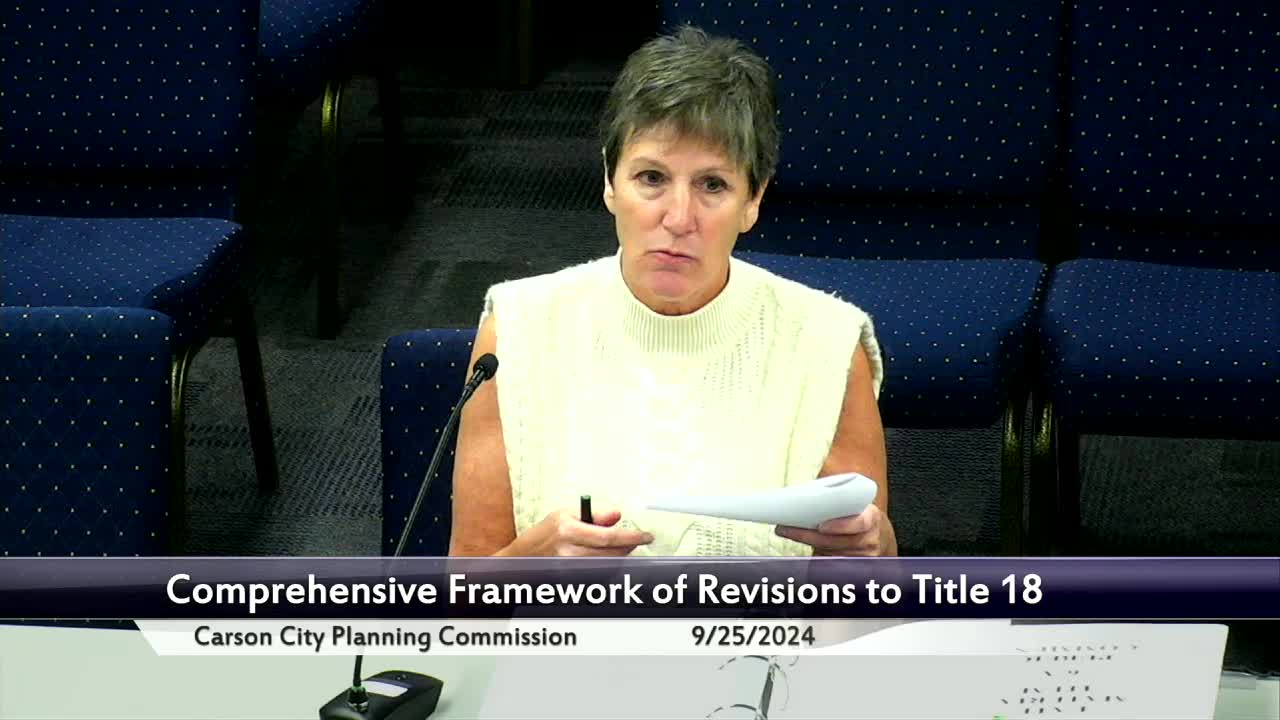Building Height Debate Sparks Controversy in Carson City
September 25, 2024 | Carson City, Ormsby County, Nevada
This article was created by AI summarizing key points discussed. AI makes mistakes, so for full details and context, please refer to the video of the full meeting. Please report any errors so we can fix them. Report an error »

In a recent government meeting, city officials discussed critical updates regarding building height regulations and environmental considerations for new developments. The fire chief confirmed that fire apparatus can effectively serve buildings up to six stories high, prompting a recommendation to set this as the maximum height for new constructions. However, the commission has yet to finalize this decision, leaving room for further discussion.
Additionally, the commission addressed language adjustments in the development guidelines to clarify that the city engineer may permit financial instruments to secure incomplete improvements before occupancy. This change aims to enhance clarity without altering the original intent of the regulations.
Another significant amendment discussed was the requirement for pollinator-friendly seed mixes in landscaping. The commission agreed to increase the percentage from 25% to 50%, reflecting a stronger commitment to environmental sustainability in new developments.
Commissioner Porter raised concerns about auxiliary buildings and their compliance with the new amendments, suggesting that the regulations should also apply to these structures. The commission acknowledged this point and agreed to consider parallel language for accessory buildings.
As the meeting progressed, various commissioners expressed their preferences regarding building heights. Commissioner DeChristopher advocated for a maximum of four stories, emphasizing the importance of maintaining the city’s small-town feel and historical character. He cautioned against allowing taller buildings, which could detract from the unique landscape of Carson City.
The discussion also touched on the potential for special use permits (SUP) to allow for additional height in certain cases, a provision already in place that could provide flexibility in the application of the new height regulations.
Overall, the meeting highlighted a collaborative effort among city officials to refine development guidelines while balancing growth with community character and environmental responsibility. Further discussions are expected as the commission continues to evaluate these proposals.
Additionally, the commission addressed language adjustments in the development guidelines to clarify that the city engineer may permit financial instruments to secure incomplete improvements before occupancy. This change aims to enhance clarity without altering the original intent of the regulations.
Another significant amendment discussed was the requirement for pollinator-friendly seed mixes in landscaping. The commission agreed to increase the percentage from 25% to 50%, reflecting a stronger commitment to environmental sustainability in new developments.
Commissioner Porter raised concerns about auxiliary buildings and their compliance with the new amendments, suggesting that the regulations should also apply to these structures. The commission acknowledged this point and agreed to consider parallel language for accessory buildings.
As the meeting progressed, various commissioners expressed their preferences regarding building heights. Commissioner DeChristopher advocated for a maximum of four stories, emphasizing the importance of maintaining the city’s small-town feel and historical character. He cautioned against allowing taller buildings, which could detract from the unique landscape of Carson City.
The discussion also touched on the potential for special use permits (SUP) to allow for additional height in certain cases, a provision already in place that could provide flexibility in the application of the new height regulations.
Overall, the meeting highlighted a collaborative effort among city officials to refine development guidelines while balancing growth with community character and environmental responsibility. Further discussions are expected as the commission continues to evaluate these proposals.
View full meeting
This article is based on a recent meeting—watch the full video and explore the complete transcript for deeper insights into the discussion.
View full meeting